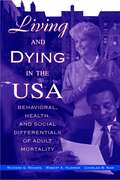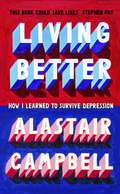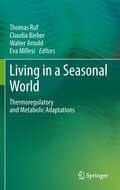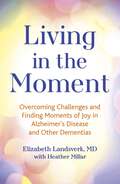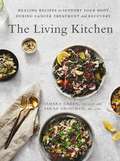- Table View
- List View
Livid: The new Kay Scarpetta thriller from the No.1 bestseller (Kay Scarpetta #26)
by Patricia CornwellTHE THRILLING NEW KAY SCARPETTA MYSTERY FROM THE #1 GLOBAL BESTSELLERMurder and mayhem. Scarpetta is back, and she's racing against the clock . . .Chief medical examiner Kay Scarpetta is the reluctant star witness in a sensational murder trial when she receives shocking news. The judge's sister has been found dead. At first glance, it appears to be a home invasion, but then why was nothing stolen, and why is the garden strewn with dead plants and insects?Although there is no apparent cause of death, Scarpetta recognizes tell-tale signs of the unthinkable, and she knows the worst is yet to come. The forensic pathologist finds herself pitted against a powerful force that returns her to the past, and her time to catch the killer is running out . . .'RIVETING' THE TIMES'CORNWELL KNOWS HOW TO CRAFT A MEAN PAGE-TURNER AND LIVID IS NO EXCEPTION' TELEGRAPH'ONE OF THE BEST CRIME WRITERS WRITING TODAY' GUARDIAN'ASTONISHING . . . THIRTY YEARS ON, THERE'S STILL NO OTHER CRIME WRITER LIKE HER' SUNDAY TIMES
Living Allergy Free: How to Create and Maintain an Allergen- and Irritant-Free Environment
by Edwin L. Klingelhofer M. Eric GershwinIn this commonsense book, Dr. Gershwin and Dr. Klingelhofer offer sensible, practical strategies for identifying the substances that cause allergies (allergens), the symptoms they cause, ways exposure to allergens can be avoided or reduced, and ways you can relieve the symptoms. Living Allergy Free also treats some reactions that are commonly assumed to be allergies, but are really sensitivity or irritant reactions, shows how they can be distinguished from true allergies, and tells you what to do about them. If you suffer from allergies-or if you think you do-Living Allergy Free is just what the doctor would order!
Living and Dying in the USA: Behavioral, Health, and Social Differentials of Adult Mortality
by Richard G. Rogers Robert A. Hummer Charles B. NamThe simplicity of using one data set in addressing the relationship of single variables to mortality distinguishes Living and Dying in the USA from other recent investigations of mortality. The authors use the recently released National Health Interview Survey and the National Death Index to make a definitive statement about demographics and mortality. By surveying demographic and sociocultural characteristics associated with mortality, socioeconomic effects, health-related conditions, and health status, they reveal connections among several factors related to mortality chances. Easily understood and cited, their study emphasizes the statistical methods underlying their revelations and invites readers to duplicate their results.Comprehensive coverage of US adult mortality differentialsBased on a new and innovative data setIncludes factors rarely examined in related mortality researchNot only documents mortality differentials, but explores explanations for themExtensive list of references associated with each chapterConsistent, straightforward methodology used throughout aids readers in both understanding the content and in comparing results from chapter to chapter
Living and Dying Well (Critical Issues in Social Justice)
by Lewis PetrinovichLiving and Dying Well takes an informed, interdisciplinary approach to the problems, data, theory, and procedures that a just society must consider when establishing policies regarding human life and death. Leading psychologist Lewis Petrinovich expands on the controversial arguments developed in his earlier work, Human Evolution, Reproduction, and Morality, and considers such contemporary issues as: the morality of human genetic screening and of the Human Genome Project; organ transplants; the allowance of suicide and euthanasia; and physicians assisting in the dying process.
Living and Dying with AIDS
by NancyAhmed Paul I. AhmedIn this nation, in this decade, there is only one way to deal with an individual who is sick-with dignity, with compassion, care and confidentiality, and without discrimi nation. Statement made by President George Bush at the National Business Leadership Conference This book is about the care of sick human beings. It is about the heroic struggle of individuals with AIDS. It is about their daily coping in the workplace and at home; about economic problems, the loss of friendship and family support, and physical and emotional pain. But it is also about empowering them to deal with their disease, viewing them not as victims but as warriors, vital and active par ticipants in their battle against AIDS. This book is also about the social context in which HIV-infected persons and people with AIDS live. It is about how we must learn to deal with sickness in more compassionate and humanitarian ways and what we yet need to learn. It touches on the health care system that confronts those who are ill, on programs of prevention and education, and on the personal implications of broader national and local policies.
Living Better: How I Learned to Survive Depression
by Alastair CampbellLast Christmas I almost killed myself. Almost. I've had a lot of almosts. Never gone from almost to deed. Don't think I ever will. But it was a bad almost. Living Better is Alastair Campbell's honest, moving and life affirming account of his lifelong struggle with depression. It is an autobiographical, psychological and psychiatric study, which explores his own childhood, family and other relationships, and examines the impact of his professional and political life on himself and those around him. But it also lays bare his relentless quest to understand depression not just through his own life but through different treatments. Every bit as direct and driven, clever and candid as he is, this is a book filled with pain, but also hope -- he examines how his successes have been in part because of rather than despite his mental health problems -- and love. We all know someone with depression. There is barely a family untouched by it. We may be talking about it more than we did, back in the era of 'boys don't cry' - they did you know - and when a brave face or a stiff upper lip or a best foot forward was seen as the only way to go. But we still don't talk about it enough. There is still stigma, and shame, and taboo. There is still the feeling that admitting to being sad or anxious makes us weak. It took me years, decades even to get to this point, but I passionately believe that the reverse is true and that speaking honestly about our feelings and experiences (whether as a depressive or as the friend or relative of a depressive) is the first and best step on the road to recovery. So that is what I have tried to do here.
Living Better with Dementia: Good Practice and Innovation for the Future
by Shibley RahmanWith currently evolving dementia policy, how can we ensure that living well with dementia continues to be a primary aim for future national dementia strategies? This book looks at current policy and research to determine emerging challenges, and what they mean for practice, both nationally and within a global context.
The Living Brain and Alzheimer’s Disease (Research and Perspectives in Alzheimer's Disease)
by YvesChristen Jean-FrançoisDemonet Bradley T. HymanFrom large cross-sectional studies of autopsy material, it seems as if a time course of Alzheimer's Disease, at least on average, can be mapped out: a pattern of hierarchical vulnerability for neuronal loss and neurofibrillary tangles beginning in medial temporal lobe structures proceeding through association areas. Plaques follow their own temporal course, with widespread cortical deposits occurring even early in a disease process. The whole process may well take twenty years, the first half of which may be without overt symptoms.
Living Data: Making Sense of Health Bio-Sensing
by Maggie Mort Celia RobertsAs individuals increasingly seek ways of accessing, understanding and sharing data about their own bodies, this book offers a critique of the popular claim that ‘more information’ equates to ‘better health’. In a study that redefines the public, academic and policy related debates around health, bodies, information and data, the authors consider the ways in which the phenomenon of self-diagnosis has created alternative worlds of knowledge and practises which are often at odds with professional medical advice. With a focus on data that concerns significant life changes, this book explores the potential challenges related to people’s changing relationships with traditional health systems as access to, and control over data shifts.
Living Data: Making Sense of Health Bio-Sensing
by Maggie Mort Celia RobertsAs individuals increasingly seek ways of accessing, understanding and sharing data about their own bodies, this book offers a critique of the popular claim that ‘more information’ equates to ‘better health’. In a study that redefines the public, academic and policy related debates around health, bodies, information and data, the authors consider the ways in which the phenomenon of self-diagnosis has created alternative worlds of knowledge and practises which are often at odds with professional medical advice. With a focus on data that concerns significant life changes, this book explores the potential challenges related to people’s changing relationships with traditional health systems as access to, and control over data shifts.
Living Donor Advocacy: An Evolving Role Within Transplantation
by Jennifer SteelThe inadequate supply of organs in the United States and other countries continues to drive the reliance on living donor transplantation. In 2000, representatives of the transplant community convened for a meeting on living donation in an effort to provide guidelines to promote the welfare of living donors. The consensus statement that resulted from this meeting recommended that transplant centers retain an Independent Living Donor Advocate (ILDA) to focus on the best interest of the donor. A decade later, nearly every transplant center in the United States, performing living donor surgeries, has incorporated an ILDA into their living donor screening and/or evaluation process Living Donor Advocate provides an overview of living donation and its risks, ethical challenges and future developments, as well as details about the role a Living Donor Advocate plays in the transplantation process. This book will interest health professionals across various disciplines and patients undergoing transplantation or living donor surgery.
Living Donor Kidney Transplantation: Current Practices, Emerging Trends and Evolving Challenges
by Jonas Wadström Robert GastonLiving donor kidney (LDK) transplantation has become the definitive approach to the treatment of end-stage renal failure, providing a better quality of life and the best opportunity for survival when compared with dialysis or transplantation from a deceased donor. A timely compendium of the modern day practice of LDK transplantation from a group of
Living Donor Transplantation
by Henkie P. Tan Amadeo Marcos Ron ShapiroEdited by leaders at one of the acclaimed transplant institutions in the United States, this reference covers all aspects of living donor solid organ and cellular transplantation in current clinical practice, including the kidney, liver, pancreas, lung, small bowel, islet, and hematopoietic stem cell transplantation. Detailed, engaging, and organ-
Living in a Seasonal World: Thermoregulatory and Metabolic Adaptations
by Thomas Ruf, Claudia Bieber, Walter Arnold and Eva MillesiThis book summarises the newest information on seasonal adaptation in animals. Topics include animal hibernation, daily torpor, thermoregulation, heat production, metabolic depression, biochemical adaptations, neurophysiology and energy balance. The contributors to this book present interdisciplinary research at multiple levels ranging from the molecular to the ecophysiological, as well as evolutionary approaches. The chapters of this book provide original data not published elsewhere, which makes it the most up-to-date, comprehensive source of information on these fields. The book’s subchapters correspond to presentations given at the 14th International Hibernation Symposium in August 2012 in Austria. This is a very successful series of symposia (held every four years since 1959) that attracts leading researchers in the field. Like the past symposia, this meeting – and consequently the book – is aimed not only at hibernation but at covering the full range of animal adaptations to seasonal environments. For the next four years, this book will serve as the cutting-edge reference work for graduate students and scientists active in this field of physiology and ecology..
Living in Death;€™s Shadow: Family Experiences of Terminal Care and Irreplaceable Loss
by Emily K. AbelWhat is it like to live with;¢;‚¬;€?and love;¢;‚¬;€?someone whose death, while delayed, is nevertheless foretold? In Living in Death;€™s Shadow, Emily K. Abel, an expert on the history of death and dying, examines memoirs written between 1965 and 2014 by family members of people who died from chronic disease. In earlier eras, death generally occurred quickly from acute illnesses, but as chronic disease became the major cause of mortality, many people continued to live with terminal diagnoses for months and even years. Illuminating the excruciatingly painful experience of coping with a family member;€™s extended fatal illness, Abel analyzes the political, personal, cultural, and medical dimensions of these struggles.The book focuses on three significant developments that transformed the experiences of those dying and their intimates: the passage of Medicare and Medicaid, the growing use of high-tech treatments at the end of life, and the rise of a movement to humanize the care of dying people. It questions the exalted value placed on acceptance of mortality as well as the notion that it is always better to die at home than in an institution. Ultimately, Living in Death;€™s Shadow emphasizes the need to shift attention from the drama of death to the entire course of a serious chronic disease. The chapters follow a common narrative of life-threatening disease: learning the diagnosis; deciding whether to enroll in a clinical trial; acknowledging or struggling against the limits of medicine; receiving care at home and in a hospital or nursing home; and obtaining palliative and hospice care. Living in Death;€™s Shadow is essential reading for everyone seeking to understand what it means to live with someone suffering from a chronic, fatal condition, including cancer, AIDS, Alzheimer;€™s, and heart disease.
Living in Death;€™s Shadow: Family Experiences of Terminal Care and Irreplaceable Loss
by Emily K. AbelWhat is it like to live with;¢;‚¬;€?and love;¢;‚¬;€?someone whose death, while delayed, is nevertheless foretold? In Living in Death;€™s Shadow, Emily K. Abel, an expert on the history of death and dying, examines memoirs written between 1965 and 2014 by family members of people who died from chronic disease. In earlier eras, death generally occurred quickly from acute illnesses, but as chronic disease became the major cause of mortality, many people continued to live with terminal diagnoses for months and even years. Illuminating the excruciatingly painful experience of coping with a family member;€™s extended fatal illness, Abel analyzes the political, personal, cultural, and medical dimensions of these struggles.The book focuses on three significant developments that transformed the experiences of those dying and their intimates: the passage of Medicare and Medicaid, the growing use of high-tech treatments at the end of life, and the rise of a movement to humanize the care of dying people. It questions the exalted value placed on acceptance of mortality as well as the notion that it is always better to die at home than in an institution. Ultimately, Living in Death;€™s Shadow emphasizes the need to shift attention from the drama of death to the entire course of a serious chronic disease. The chapters follow a common narrative of life-threatening disease: learning the diagnosis; deciding whether to enroll in a clinical trial; acknowledging or struggling against the limits of medicine; receiving care at home and in a hospital or nursing home; and obtaining palliative and hospice care. Living in Death;€™s Shadow is essential reading for everyone seeking to understand what it means to live with someone suffering from a chronic, fatal condition, including cancer, AIDS, Alzheimer;€™s, and heart disease.
Living in the Moment: Overcoming Challenges and Finding Moments of Joy in Alzheimer's Disease and Other Dementias
by Elizabeth LandsverkAn invaluable, comprehensive guide that explains everything you and your family need to know about living well with Alzheimer's disease and other dementias.A loved one's dementia diagnosis can leave you feeling scared and overwhelmed. Now a renowned consultant geriatrician, who has helped thousands of families live happy, engaged lives - after a dementia diagnosis - shares her expertise in this easy-to-follow guide.Filled with must-have information, practical advice, and unique and comforting insights, here is everything you need to know about caring for your loved one and making his or her life the best possible - starting now, even as the disease progresses. Inside, you'll find:* How to create a plan of action for today, and tomorrow, that will help all involved cope with this new normal* How to keep your vulnerable loved one safe and secure both physically and financially* Lifestyle changes, innovative new activities, and holistic interventions that can slow the progression of dementia* Comprehensive information on both prescription and over-the-counter medications that can help or hurt dementia patients* Dealing with day-to-day challenges, from staying mobile to overcoming agitation and aggression without resorting to sedation* How and where to get help* Tips on keeping your loved one comfortable in their own home In addition to all the essential advice, Dr. Landsverk demystifies the ins and outs of dementia, explaining what it is and what it's not, and making sure you and your loved one will be ready to address whatever develops and maintain quality of life. Uniquely, Living in the Moment will transform how you think about dementia, providing comfort and support for the best life possible - at any stage.
Living in the Shadows of China's HIV/AIDS Epidemics: Sex, Drugs and Bad Blood (Routledge Contemporary China Series)
by Shelley TorcettiIdentifying the existing challenges and shortfalls of China's current HIV/AIDS programming, this book provides an understanding of the history of HIV/AIDS in China, comparing government responses to global best practice in prevention and treatment. Considering three key populations in China, namely, female sex workers, people who inject drugs and floating migrants, Living in the Shadows of China's HIV/AIDS Epidemics highlights the effects of high mobility and marginalisation on the spread of HIV in China. It is argued that these groups often suffer from stigmatisation and a lack of human security, resulting in sub-optimal outcomes for HIV/AIDS intervention and prevention efforts and the reinforcement of high-risk behaviours, further contributing to the transmission of the virus to the general population. In adding to the emerging body of literature, this book further elucidates the myriad of challenges posed by HIV/AIDS epidemics, allowing sustained engagement and a fresh insight into how governments might respond to the needs of individuals living with HIV/AIDS, both in China and globally. Including case studies which give voice to research participants in a rich and engaging way, this book will appeal to students and scholars of Chinese Studies, Asian Studies, International Relations and Political Science, as well as those engaged in epidemiological studies in the Health Sciences.
Living in the Shadows of China's HIV/AIDS Epidemics: Sex, Drugs and Bad Blood (Routledge Contemporary China Series)
by Shelley TorcettiIdentifying the existing challenges and shortfalls of China's current HIV/AIDS programming, this book provides an understanding of the history of HIV/AIDS in China, comparing government responses to global best practice in prevention and treatment. Considering three key populations in China, namely, female sex workers, people who inject drugs and floating migrants, Living in the Shadows of China's HIV/AIDS Epidemics highlights the effects of high mobility and marginalisation on the spread of HIV in China. It is argued that these groups often suffer from stigmatisation and a lack of human security, resulting in sub-optimal outcomes for HIV/AIDS intervention and prevention efforts and the reinforcement of high-risk behaviours, further contributing to the transmission of the virus to the general population. In adding to the emerging body of literature, this book further elucidates the myriad of challenges posed by HIV/AIDS epidemics, allowing sustained engagement and a fresh insight into how governments might respond to the needs of individuals living with HIV/AIDS, both in China and globally. Including case studies which give voice to research participants in a rich and engaging way, this book will appeal to students and scholars of Chinese Studies, Asian Studies, International Relations and Political Science, as well as those engaged in epidemiological studies in the Health Sciences.
Living Kidney Donation: Best Practices in Evaluation, Care and Follow-up
by Edgar V. Lerma Krista L. Lentine Beatrice P. ConcepcionThis book provides a complete guide to the evaluation, care, and follow-up of living kidney donors. Living donor kidney transplantation is established as the best treatment option for kidney failure. However, despite the tremendous benefits of living donation to recipients and society, the outcomes and optimal care of donors themselves have received relatively less attention. Fortunately, things are changing – including recent landmark developments in living donor risk assessment, policy and guidance. This volume offers authoritative, evidence-based guidance on the full range of clinical scenarios encountered in the evaluation and care of living kidney donors. The approach to key elements of risk assessment, ethical considerations and informed consent is accompanied by recommendations for patient-centered care before, during, and after donation. Advocacy initiatives and policies to remove disincentives to donation and advance a defensible system of practice are also discussed. General and transplant nephrologists, as well as related allied health professionals, can look to this book as a comprehensive resource addressing contemporary clinical topics in the practice of living kidney donation.
Living Kidney Donation: A Practical Guide
by Adnan Sharif Graham LipkinThis book provides a guide to the principles and practice of living kidney donation. Concise and well-structured chapters discuss the ethics of living kidney donation, medical evaluation of kidney donors, donor nephrectomy surgery, and long-term outcomes of transplantation, along with broader medical issues related to cardiology, surgery, and anesthesia. Living Kidney Donation: A Practical Guide aims to give readers the essential information required for undertaking living kidney donation and is relevant to nephrologists, transplant surgeons, and healthcare professionals working in renal transplantation.
The Living Kitchen: Healing Recipes to Support Your Body During Cancer Treatment and Recovery
by Tamara Green Sarah GrossmanFrom two experts in cancer care cooking comes an informative, inspiring and empowering guide that will educate cancer patients and their caregivers about the healing power of food.With nearly 100 recipes - all stress-free, healthy, freezer-friendly and flavorful - specially designed to relieve specific symptoms and side effects of cancer and its therapies (including loss of appetite, sore mouth, altered taste buds, nausea, and more) and to strengthen your body once in recovery, The Living Kitchen is accompanied by stunning photography and a simple, user-friendly design. In this indispensable guide, certified nutritionists Sarah Grossman and Tamara Green provide easy-to-understand, research-based nutritional information on the science of how food relates to your health and the effects of cancer, and offer strategies to prepare your body, life and kitchen for treatment.You will find recipes for:- Energising snacks and breakfasts- Superfood smoothies, juices and elixirs- Soups and stews- Nutrient-rich, delicious main dishesThese are recipes that you, your family, and your caregivers will all enjoy. The Living Kitchen will give you comfort in knowing that your body will be nourished and supported during (and even after) cancer treatment.A cancer diagnosis can be overwhelming, frightening and uncertain. You'll want to learn what to expect from chemotherapy and radiation, how you'll navigate the often debilitating side effects that come with treatment, and what you should eat to support your body at a time when eating and cooking may be too challenging. The Living Kitchen will help cancer patients and their caregivers navigate every stage of their cancer therapy journey, from diagnosis to treatment to recovery.
Living Longer and Healthier at Older Ages: A Longitudinal Analysis of Chinese Oldest Old’s Health and Its Determinants (Advances in Studies of Aging and Health #3)
by Li ZhangThis book analyzes data from eight waves (1998, 2000, 2002, 2005, 2008, 2011-12, 2014 and 2018) of the Chinese Longitudinal Healthy Longevity Surveys (CLHLS) to explore how health status of the Chinese oldest old has changed over time and across birth cohorts. It also intends to investigate how period and birth cohorts have played a role in the associations between Chinese oldest old’s health and a variety of demographic, socioeconomic, and lifestyle factors. The book applies the age-period-cohort (APC) approach and constructs cross-classified random-effects models (CCREMs) to carry out the analyses. The oldest old’s health is measured by self-rated health (SRH), chronic diseases, cognitive function and subjective wellbeing which is indicated by positive and negative feeling scores. The results show that Chinese oldest old’s health status has changed over time and across birth cohorts. Significant period and cohort effects are shown when linking Chinese oldest old’s health to various demographic, socioeconomic and health lifestyle covariates. In general, period effects surpass the cohort effects. Particularly, the oldest old’s subjective wellbeing is more likely to be influenced by period than cohort effects. Period changes caused by social events, such as economic hardship and natural disasters, have left strong imprints on Chinese oldest old’s mental than physical health status. Based on these findings, the book highlights some important policy implications and points out future research directions to improve the current study. It provides an interesting read for researchers in gerontology and public health studies. It is also of interest to general audience, including practitioners in health care and policy makers who are interested in old age care and healthy aging policies.
Living Longer, Living Better: Exploring the Heart-Mind Connection
by Lionel H. OpieLiving Longer: The heart-mind connection is written for all those who strive for optimal long-term health and the maximal functioning of their hearts and minds. Today's problem for the health-conscious individual is information overload - new health studies pour out almost daily from newspapers, radio stations and television networks. Many of the reports are contradictory and often misleading. In this book, Professor Opie sifts through the available information on the vast number of possible health promotion changes, varying from increased exercise to aspirin to green tea, and diets from Atkins to the vegetarian, with the aim of grading the validity of the evidence, asking questions such as, "Just how true are the studies" and "Just how compelling are the facts they claim"? Living Longer guides the reader through this morass of information with the message that just five key steps taken now will promote long-term health benefits for heart and mind and give protection from future heart disease and brain deterioration.
Living machines: A handbook of research in biomimetics and biohybrid systems
by Tony J. Prescott, Nathan F. Lepora and Paul F. M. J. VerschureContemporary research in science and engineering is seeking to harness the versatility and sustainability of living organisms. By exploiting natural principles, researchers hope to create new kinds of technology that are self-repairing, adaptable, and robust, and to invent a new class of machines that are perceptive, social, emotional, perhaps even conscious. This is the realm of the 'living machine'. Living machines can be divided into two types: biomimetic systems, that harness the principles discovered in nature and embody them in new artifacts, and biohybrid systems in which biological entities are coupled with synthetic ones. Living Machines: A handbook of research in biomimetic and biohybrid systems surveys this flourishing area of research, capturing the current state of play and pointing to the opportunities ahead. Promising areas in biomimetics include self-organization, biologically inspired active materials, self-assembly and self-repair, learning, memory, control architectures and self-regulation, locomotion in air, on land or in water, perception, cognition, control, and communication. Drawing on these advances the potential of biomimetics is revealed in devices that can harvest energy, grow or reproduce, and in animal-like robots that range from synthetic slime molds, to artificial fish, to humanoids. Biohybrid systems is a relatively new field, with exciting and largely unknown potential, but one that is likely to shape the future of humanity. This book surveys progress towards new kinds of biohybrid such as robots that merge electronic neurons with biological tissue, micro-scale machines made from living cells, prosthetic limbs with a sense of touch, and brain-machine interfaces that allow robotic devices to be controlled by human thought. The handbook concludes by exploring some of the impacts that living machine technologies could have on both society and the individual, exploring questions about how we will see and understand ourselves in a world in which the line between the natural and the artificial is increasingly blurred. With contributions from leading researchers from science, engineering, and the humanities, this handbook will be of broad interest to undergraduate and postgraduate students. Researchers in the areas of computational modeling and engineering, including artificial intelligence, machine learning, artificial life, biorobotics, neurorobotics, and human-machine interfaces will find Living Machines an invaluable resource.


